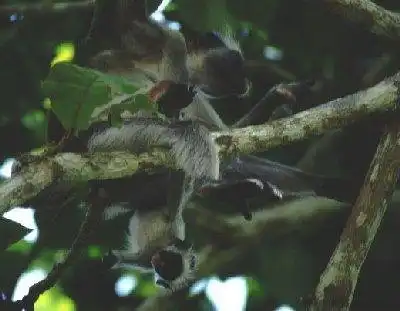Jozani Forest Reserve
The island of Zanzibar, off the coast of Dar es Salaam, Tanzania, is famous for its Arab-style towns and beautiful sea, but that is not all there is to see. In fact, there is much more to see than that. The island is dotted with old ruins, as it was already a prosperous port town when Vasco da Gama came to Tanzania. I like ruins and have seen them all over the world, but the ones in Zanzibar are so small in scale that almost no one visits them and there is no way to visit them.
Jozani Forest Reserve tours in Zanzibar
There are several tours available for Jozani Froest Reserve. Some tours just visit Jozani Forest while other tours are combined with the visit to other places such as Zanzibar Stone Town. Most of the tours depart from Zanzibar port or Stone Town, not Dar es Salaam. This is probably because Zanzibar is an independent nation and you need to bring passport when you cross from Dar es Salaam to Zanzibar Island.
Red colobus inhabiting Zanzibar
One thing I really wanted to see in Zanzibar was monkeys. Zanzibar is home to the Zanzibar Red Colobus, a rare species of monkey that lives only in Zanzibar. As an animal lover, I couldn't miss it. This monkey is similar to the black and white colobus monkeys that lives in Arusha National Park, but Zanzibar Red Colobus has red hair and is a little smaller. Zanzibar was once connected to the African continent, and it seems to have evolved on its own from ancestors who came over at that time.

Red colobus are said to be distributed throughout Zanzibar, but here, as usual, they are losing territorial battles with humans and are declining. One place where they can be seen for sure is the Jozani Forest Reserve, less than an hour's drive from the center of Zanzibar, where an attempt is being made to preserve not only the monkeys, but also the few remaining academically valuable forests in the ecosystem.
Well, the monkeys are surprisingly found outside the reserve. They can be found in the forest, but it is difficult to see them. It is possible to approach groups that have come out of the forest and are no longer afraid of people. Of course, you can't feed them out of your hand.
The monkeys are smaller than expected and have red hair. Being arboreal monkeys by nature, the troop jumps from tree to tree in search of food. They jump from one tree to another, only a few meters away from where I was watching them. Only the mother monkeys with their young go down to the ground before moving on. There are about 70 monkeys in this group, and I watched them pass in front of me one after another, entranced.
The monkeys that come out to the human settlement are said to destroy crops in the neighborhood, but the local people also benefit from the entrance fee to the protected forest, so that the local people and the monkeys can coexist in harmony.
In Japan, monkey researchers often name monkeys to identify them. I checked with ranger to be sure, and he told me that individual monkeys are not named here.
We didn't have much time and could only spend about 30 minutes in the forest. It is a rare forest that was established in a location where the groundwater level is several tens of centimeters below the surface. As I was walking through the fallen leaves, I saw something black about 1 cm in diameter bouncing around my feet. I thought it was a cricket, but upon closer inspection it turned out to be a small frog. I was surprised to see a small black snake, only about 20 centimeters long, that was after the frog. It was a wonderful place that I would like to visit again with a full set of camera if I have a chance.